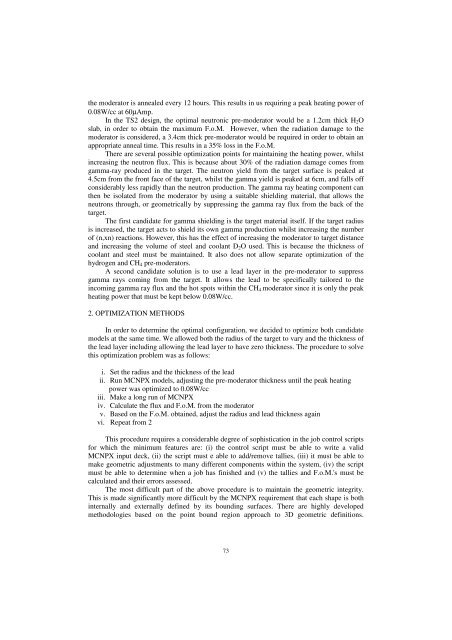Druck-Materie 20b.qxd - JUWEL - Forschungszentrum Jülich
Druck-Materie 20b.qxd - JUWEL - Forschungszentrum Jülich
Druck-Materie 20b.qxd - JUWEL - Forschungszentrum Jülich
Create successful ePaper yourself
Turn your PDF publications into a flip-book with our unique Google optimized e-Paper software.
the moderator is annealed every 12 hours. This results in us requiring a peak heating power of<br />
0.08W/cc at 60µAmp.<br />
In the TS2 design, the optimal neutronic pre-moderator would be a 1.2cm thick H2O<br />
slab, in order to obtain the maximum F.o.M. However, when the radiation damage to the<br />
moderator is considered, a 3.4cm thick pre-moderator would be required in order to obtain an<br />
appropriate anneal time. This results in a 35% loss in the F.o.M.<br />
There are several possible optimization points for maintaining the heating power, whilst<br />
increasing the neutron flux. This is because about 30% of the radiation damage comes from<br />
gamma-ray produced in the target. The neutron yield from the target surface is peaked at<br />
4.5cm from the front face of the target, whilst the gamma yield is peaked at 6cm, and falls off<br />
considerably less rapidly than the neutron production. The gamma ray heating component can<br />
then be isolated from the moderator by using a suitable shielding material, that allows the<br />
neutrons through, or geometrically by suppressing the gamma ray flux from the back of the<br />
target.<br />
The first candidate for gamma shielding is the target material itself. If the target radius<br />
is increased, the target acts to shield its own gamma production whilst increasing the number<br />
of (n,xn) reactions. However, this has the effect of increasing the moderator to target distance<br />
and increasing the volume of steel and coolant D2O used. This is because the thickness of<br />
coolant and steel must be maintained. It also does not allow separate optimization of the<br />
hydrogen and CH4 pre-moderators.<br />
A second candidate solution is to use a lead layer in the pre-moderator to suppress<br />
gamma rays coming from the target. It allows the lead to be specifically tailored to the<br />
incoming gamma ray flux and the hot spots within the CH4 moderator since it is only the peak<br />
heating power that must be kept below 0.08W/cc.<br />
2. OPTIMIZATION METHODS<br />
In order to determine the optimal configuration, we decided to optimize both candidate<br />
models at the same time. We allowed both the radius of the target to vary and the thickness of<br />
the lead layer including allowing the lead layer to have zero thickness. The procedure to solve<br />
this optimization problem was as follows:<br />
i. Set the radius and the thickness of the lead<br />
ii. Run MCNPX models, adjusting the pre-moderator thickness until the peak heating<br />
power was optimized to 0.08W/cc<br />
iii. Make a long run of MCNPX<br />
iv. Calculate the flux and F.o.M. from the moderator<br />
v. Based on the F.o.M. obtained, adjust the radius and lead thickness again<br />
vi. Repeat from 2<br />
This procedure requires a considerable degree of sophistication in the job control scripts<br />
for which the minimum features are: (i) the control script must be able to write a valid<br />
MCNPX input deck, (ii) the script must e able to add/remove tallies, (iii) it must be able to<br />
make geometric adjustments to many different components within the system, (iv) the script<br />
must be able to determine when a job has finished and (v) the tallies and F.o.M.'s must be<br />
calculated and their errors assessed.<br />
The most difficult part of the above procedure is to maintain the geometric integrity.<br />
This is made significantly more difficult by the MCNPX requirement that each shape is both<br />
internally and externally defined by its bounding surfaces. There are highly developed<br />
methodologies based on the point bound region approach to 3D geometric definitions.<br />
73

















